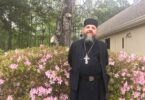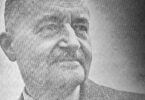“It is true that the policy of Nazi Germany tried to make extensive use of religious opposition groups in the occupied areas and strongly supported them.” [1]Troitsky, S.V. On the untruth of the Karlovtsy Schism Paris, 1960 p. 85 The Soviets obviously used the same tactics when they occupied Western Byelorussia, quickly placing the anti-Polish Autocephaly factions under the Moscow Patriarchate. The Germans added nationalism to the mix; their policy in Ukraine was basically the same as their policy in Byelorussia. When the Germans occupied both Ukraine and Byelorussia, Ukrainian and Byelorussian nationalists followed in their wake, and were used by the Germans in the capacity of civil officials of the occupation authority, as well as to spread the “Gospel” of nationalism. The Germans preached anti-bolshevism, too … it was not known by the nationalist factions in the occupied territories that German plans called for these territories to be used simply as pools of slave labor and natural resources for the Reich … the nationalists believed, however naively, that they would soon be governing their own homelands, free from “Russian domination.” “German policy also played a role in the division of the Orthodox communion. Fundamentally, Nazi policy was permeated with violent hatred of all religion. The guiding principle for selection of German officials for the east ensured that this basic theme would persist in the application of policy … Within this blanket opposition to the church, however, even the fanatical anticlericalism of Rosenberg and his staff permitted compromises to secure tactical advantages … the Orthodox Church was not to be opposed openly provided it was not Russian dominated but Ukrainian [ or Byelorussian ] in character … It was hoped that by allowing a multitude of religious bodies the Orthodox Church as such would be weakened … “ [2]Armstrong, John A. Ukrainian Nationalism, 1939-1945 N.Y., 1955 pp. 198-199 The German policy in both Ukraine and Byelorussia failed for a variety of reasons, the foremost being the involvement of numerous entities and factions within cliques of policymakers in Berlin, and the Wehrmacht and occupation authorities in the occupied territories. As is usual in war, the theoretician in an office and the commander in the field have vastly different problems and realities to deal with. If the Orthodox Church was, indeed, “weakened” as a result of the War [an arguable proposition, undoubtedly], this was more the fault of the various hierarchies scrambling for jurisdictional benefit to themselves, a phenomenon long predating the German occupation of Soviet territory. One need look no farther than the response of the Patriarchate of Constantinople to the troubles, suffering and persecution of the Russian Church after 1917.
In Sep 1940, Metropolitan Dionisii swore his obedience and loyalty to the German General Government of occupied Poland, as well as the same from all his clergy, and the Autocephalous Church of Poland was “reborn,” as it were. The change in policy by the Germans was due to their desire to play the “Ukrainian card” in their upcoming war with the Soviet Union. The Germans encouraged Ukrainian nationalist sentiment, as well as a Ukrainian Autocephalous Church. As part of the deal of Dionisii s return to power, he promised to consecrate the “famous Ukrainian scientist,” Professor I. Ohienko, tonsured as “Ilarion,” to the episcopate. The consecration was performed by Metropolitan Dionisy, Bishop Timothy (Shretter) of Lublin of the Polish Church, and Bishop Savvatie of Prague, head of the Diocese of the Patriarchate of Constantinople in Czechoslovakia (the creation of which completely ignored the longstanding jurisdiction of the Serbian Orthodox Church in Czechoslovakia). After the consecration of Bishop Ilarion (Ohienko), the Saint Mary Magdalene Cathedral in Warsaw was “completely Ukrainianised,” as was the Warsaw Theological Consistory. Only Ukrainians were appointed to the newly composed Consistory by Metropolitan Dionisii; all services in the upper church (that is, the main part of the Cathedral) were conducted in Ukrainian, Ukrainian language Prayer and Liturgical books were printed, a Ukrainian Seminary was established, and the non-Ukrainian Orthodox in Warsaw were relegated to the basement chapel in the Cathedral. [3]op. cit. 37
After the Germans went to war with the Soviet Union, Metropolitan Dionisii also had his eye on the Church in Byelorussia. A “Byelorussian Committee,” composed of Byelorussian nationalists, had thought to have Dionisy involved in the Byelorussian Church, The Committee also named candidates for the episcopate in Byelorussia. Unfortunately for the Committee, their candidates did not share their “plans” for the Byelorussian Church. The Germans, not interested in unity among the Orthodox in their new dominions, likewise had no interest in Metropolitan Dionisy inserting himself into the situation. Also, since Dionisy had been partially behind the exile and house arrest of Vladika Panteleimon for nearly 20 years, his participation in any way with the Byelorussian Church was most definitely unwanted inside Church circles in Byelorussia. [4]I. Kasyak, Z Gistori Pravaslavnai Tsarkvi Belaruskaga Narodu Belarusian Central Rada, NY, 1956 pp. 80-98
There were enormous labors for the servants of the Church to contend with in German occupied Byelorussia. The primary task was gaining the resources necessary to serve the great numbers who desired to be able to go to church, to take the Holy Mysteries, to be baptized, to learn about the Holy Church after being in the Soviet spiritual desert for more than twenty years. Unfortunately, the task of the Hierarchs and clergy was made more difficult by the demands of Byelorussian nationalists who knew little or nothing of Church life, and simply wanted a church organization based on purely nationalist grounds, with absolutely no knowledge of nor concern for the requirements of the Church itself. With the German occupation forces securely in control, and a “trustworthy” government of Byelorussian nationalists installed by them, “Archbishop Panteleimon was chosen as the Metropolitan of Minsk and All Byelorussia.” [5]op. cit. 56
In Sep 1941, Bishop Venedikt travelled to Minsk from the Zhirovitsky Monastery to get permission from the German occupation authorities to begin to organize Church life. He was helped in Minsk by Radyslav Ostrovsky, a Byelorussian nationalist in the German occupation authority. They discussed “discussed all questions concerning the organization of Church life” in Byelorussia. Ostrovsky requested immediately that the discussions be held “in the Byelorussian national spirit,” and further immediately demanded that all future Hierarchs of the Church be of Byelorussian nationality. [6]op. cit. 56
“Through the Bishop Venedikt, R. Ostrovskii received from the General Commissariat of Belarus (military and civilian German occupation authorities) a letter to Metropolitan Panteleimon (Rozhnovskii) on October 3, 1941, in which were laid down the following conditions: a) The Orthodox Church in Belarus is guided by the holy canons, and German authorities did not interfere in its internal life, and b) the Orthodox Church in Belarus should be called “the Belarusian Autocephalous Orthodox Church National”, c) the preaching, teaching the Law of God and the church pismovodstvo should be in the Belarusian language, d) the appointment of bishops, deans, and priests should not be made without the knowledge of the German government, and e) shall be submitted to the statute, “the Belarusian Autocephalous Orthodox Church of the National”, e) the service must be performed in Church Slavonic.
References
| ↵1 | Troitsky, S.V. On the untruth of the Karlovtsy Schism Paris, 1960 p. 85 |
|---|---|
| ↵2 | Armstrong, John A. Ukrainian Nationalism, 1939-1945 N.Y., 1955 pp. 198-199 |
| ↵3 | op. cit. 37 |
| ↵4 | I. Kasyak, Z Gistori Pravaslavnai Tsarkvi Belaruskaga Narodu Belarusian Central Rada, NY, 1956 pp. 80-98 |
| ↵5 | op. cit. 56 |
| ↵6 | op. cit. 56 |










